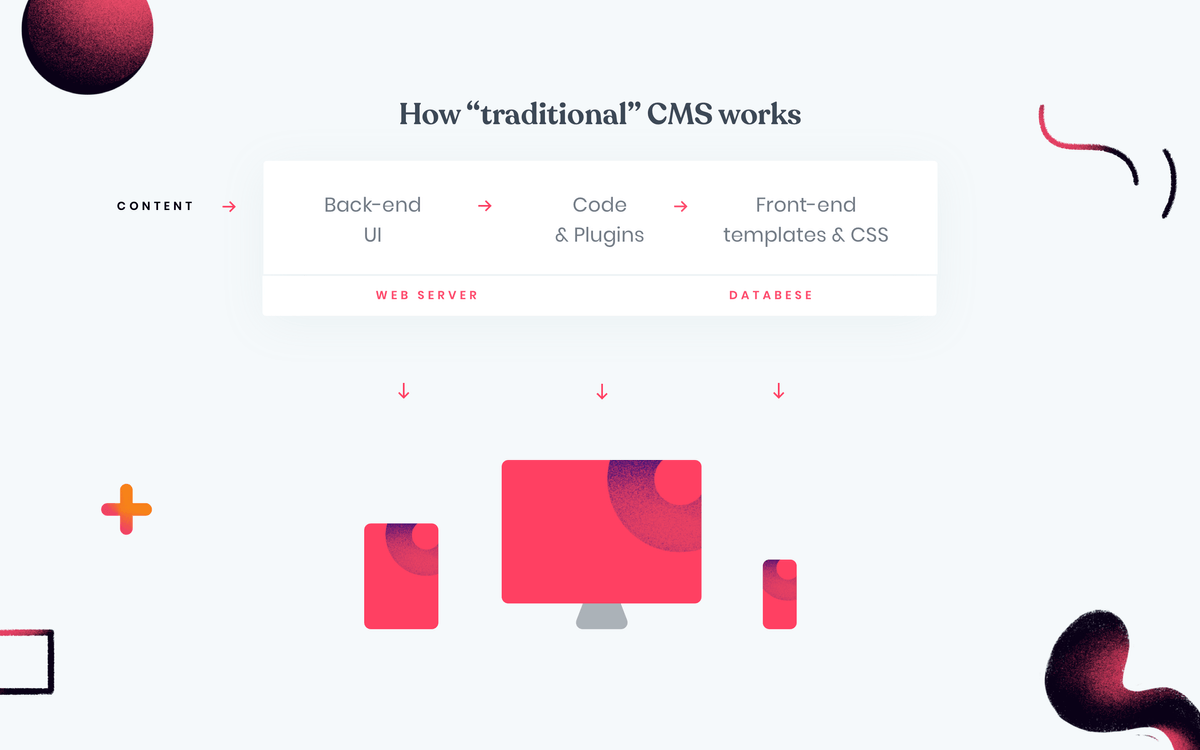
Jamstack SEO Guide
Whether you are running a Jamstack website or not, this is a comprehensive overview of everything you need to know to succeed at SEO.
Read article »Throughout 2020 the headless CMS trend showed no signs of slowing. In 2021 you can expect the trend to grow beyond buzzword popularity as more and more brands turn to headless options for their content management.
Nebojsa Radakovic
We can’t say that headless CMSs, and Jamstack for that matter, are all the rage now in web development but they are pretty close to becoming mainstream tech. A serious contender to LAMP and MEAN stacks dominance if you will.
When we talk about static websites, the first thing that comes to mind is a bunch of web pages coded using HTML, CSS, and JS. Just plain text and graphics-based interface with no interactive features and real-time processing whatsoever to facilitate the visitors.
Fortunately, that’s not the case for static websites of today.
Static websites have evolved to embrace innovative technologies and today they can do things such as handling real-time requests, processing payments, managing customer accounts, carrying out full website searches, and a lot more. That’s why we don’t call them static anymore, we now call them Jamstack websites.
OK. This might be an overstatement considering the discussions and debates we currently have about the terms we use on a day-to-day basis.
With the advent of Jamstack, we now don’t need to divert our focus on specific web technologies in terms of operating systems, web servers, frameworks, database development, management, and backend development.
Jamstack bridges the gap of functionality between static and dynamic websites while keeping the key advantages of a static website intact.
Jamstack has brought a completely refreshing method of building websites as well as apps that delivers enhanced development, maintenance, and operational efficiencies not only for the enterprise sector but individuals as well.
Simple explanation: headless CMS or headless content management system is a back-end content management system separated from your front-end presentation layer.
Take a look at this awesomely simple 2 min explanation from our friends at Sanity:
Loading Video
Loading Video
Simple right?
Traditional CMSs like Drupal and WordPress are hosted and served with the website every time a request for a page is made. This basically means that the traditional CMSs are built with back-end and front-end bundled into a single application that is web-first.
Headless CMS, as we already pointed out, decouples content management from the presentation layer. This means that your content management functionalities (like creation, management, and storage of content) are separate from your front end allowing you to deliver content beyond websites and apps. It allows you to repurpose your content from multiple front-ends making them a perfect fit for Jamstack builds.
With so many brands focusing on repurposing their content on multiple front ends, the growing demand, and the number of headless CMS solutions, should not come as a surprise. Especially when you look at all the benefits a headless CMS brings to a table:
The differences, the challenges, and the benefits of using them.
It is hard turning a blind eye to the benefits of using Jamstack (and headless CMSs for that matter) from both web developers’ and marketers’ perspectives. Faster performance, more security, and easier scalability being the top among many.
On top of that people are making use of more devices and channels than ever before. In a climate such as this, businesses/brands are forced to make omnichannel strategies to be able to get to their potential customers wherever they may be.
With that in mind, we should ask something else.
Honestly, no one but you can answer that question. Right now headless CMSs are considered future-proof mainly because of a clear distinction between the content and presentation.
However, only understanding your short-term and long-term business and content goals can help you choose which content management model will best serve your business.
Being a web dev shop we’ve had the pleasure of working with numerous headless CMS solutions so far. And being huge believers in learning in public and from the experience of others we’ve tasked ourselves to share with you our impartial reviews of the solutions we’ve used so far
For better or for worse treat the following as such i.e. pros/cons we’ve been able to muster up from the builds we did and problems we’ve come across.
Contentful
Storyblok
Sanity
Forestry
DatoCMS
Prismic
NetlifyCMS
Strapi
Headless WordPress
Tina CMS
Agility CMS
GatherContent
Kentico Kontent
GraphCMS
Craft CMS
Butter CMS
Payload CMS
Cosmic
Directus
Ghost
LexasCMS
Magnolia CMS
TakeShape
Contentstack
KeystoneJS
According to one research headless approach is now well-entrenched within the majority of enterprise organizations. 64% of enterprise organizations are currently using a headless approach (a 25% increase over 2019).
Another research predicts the headless CMS software market to grow 22.6% from 2020 to 2027.
If those numbers are not enough, more and more devs from both sides that usually collide ie WordPress devs and almost everybody else, are finding solutions that utilize headless WordPress benefits. We’re having static/headless WordPress platforms like Stratic for example emerging from one side and effective use of WordPress as a back-end solution like in the case of Gatsby blog come from the other.
What more big brands in many different industries opt-out to a headless WordPress solution. Like TechCrunch or Backlinko for example.
All this means the future is bright for the headless approach and we can expect a great many things to come.
We’re back to the question Does Your Business Need Headless CMS? And, as we already said, it depends on your business requirements.
Being a WebDev shop focused on helping agencies and companies with serverless web, static site generators, and Jamstack tools we can certainly help you answer that. Let’s get in touch!
Whether you are running a Jamstack website or not, this is a comprehensive overview of everything you need to know to succeed at SEO.
Read article »Discover a couple of Jamstack hosting and cloud deployment platforms favored by the community.
Read article »The world of static sites has grown beyond HTML, CSS, and occasional JS, and much of it is owed to static site generators.
Read article »




